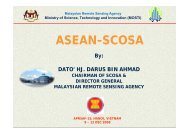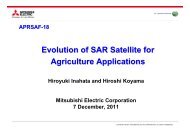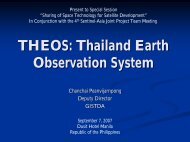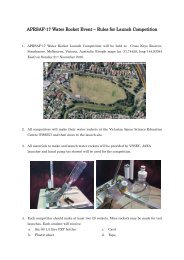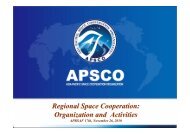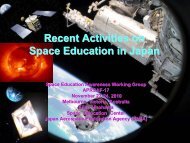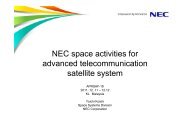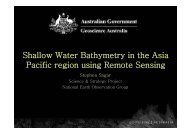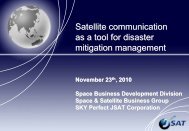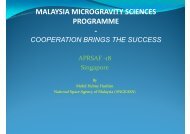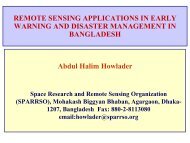Meeting Summary (Cont d) - aprsaf
Meeting Summary (Cont d) - aprsaf
Meeting Summary (Cont d) - aprsaf
You also want an ePaper? Increase the reach of your titles
YUMPU automatically turns print PDFs into web optimized ePapers that Google loves.
Communication Communication Satellite Applications WG<br />
WG<br />
Chairman’s <strong>Summary</strong> Report<br />
Co Co-chairs: chairs:<br />
Dr. ONG Jin Teong, C2N Pte. Ltd.<br />
Hiroki Hiroki Kohata Kohata, JAXA<br />
APRSAF APRSAF-18 18 Si Singapore<br />
December 9 th , 2011
�� Objectives<br />
CONTENT<br />
�� Point of Discussion<br />
�� �� Participants Participants and Presentations<br />
�� <strong>Meeting</strong> g <strong>Summary</strong> y<br />
�� Recommendations<br />
1
Objectives<br />
�� In order to promote a ne new application of the satellite<br />
communications in the Asia-Pacific Asia Pacific region, the CSA WG;<br />
�� provide good opportunities to exchange each<br />
country’s status about digital divide issues as well as<br />
the broadband service,<br />
�� share information and experience p based upon p the<br />
actual use for realizing cooperation among countries,<br />
2
Point Point of Discussion<br />
�� The The CSA CSA WG WG in in the the APRSAF APRSAF-18 18 aims aims discussed; disc ssed<br />
A) New applications of or concepts for satellite<br />
communication for tele-education, tele education, tele tele-medicine medicine and<br />
disaster management in the Asia-Pacific Asia Pacific region<br />
1. <strong>Cont</strong>ribution of communications satellite to Great<br />
East Japan Earthquake<br />
2. Information sharing g of technical trend for ship p<br />
monitoring in the Pacific region (Joint Session<br />
with EO WG)<br />
B) Promotion of of activities activities on Global Navigation Satellite<br />
System (GNSS) in the Asia Asia-Pacific Pacific region.<br />
3
Participants and Presentations<br />
�� �� 32 participants<br />
participants<br />
from 11 countries<br />
• Indonesia, Japan, Korea, Lao PDR, Malaysia, Mongolia,<br />
Pakistan Pakistan, Singapore Singapore, Thailand Thailand, Turkey Turkey, USA<br />
from 1 organizations<br />
• UNESCAP<br />
�� 23 presentations<br />
• 4 presentations : : <strong>Cont</strong>ribution <strong>Cont</strong>ribution of of communications communications satellites<br />
satellites<br />
to Great East Japan Earthquake<br />
• 6 presentations : Communications Satellite Systems and<br />
Applications<br />
• 6 presentations : Activity reports on the Communications<br />
Satellite Application<br />
• 1 presentations : Activity reports on the Global Navigation<br />
Satellite System (GNSS)<br />
• 6 presentations p<br />
: Share the information of technical trend<br />
for ship monitoring in the Pacific region<br />
(Joint session with EO WG )<br />
4
<strong>Meeting</strong> <strong>Summary</strong><br />
<strong>Summary</strong><br />
A) <strong>Cont</strong>ribution of of communications communications satellites satellites to Great East<br />
Japan Earthquake<br />
• Restoration support activities using communications<br />
satellites after the earthquake were provided by JAXA,<br />
NICT NICT, Sky Sky Perfect JSAT and LASCOM LASCOM, and their<br />
experiences were shared in the WG.<br />
• The e WG G recognized ecog ed t that at t the e co communications u cat o s sate satellite te<br />
networks were indispensable and played a major role in<br />
the restoration after the earthquake.<br />
• R Required i d satellite t llit system t i in th the di disaster t l learned d f from<br />
these activities were also introduced.<br />
�� �� Immediate provision of emergency information and<br />
broadband satellite internet access<br />
�� Small and portable p g ground terminal<br />
�� Flexible power supply<br />
5
<strong>Meeting</strong> <strong>Summary</strong> <strong>Summary</strong> (<strong>Cont</strong>’d)<br />
(<strong>Cont</strong> d)<br />
B) Communications Satellite Satellite Systems and Applications<br />
• Satellite operators (Turksat (Turksat, Thaicom and SingTel) and<br />
ICTPA, government of Mongolia provided the<br />
information about their current and planned satellite<br />
fl fleet t and d th their i satellite t llit communications i ti applications li ti<br />
such as;<br />
�� �� Disaster relief<br />
�� Distant education<br />
�� �� e-government<br />
e government<br />
�� Maritime communications<br />
�� Ka Ka-band Ka band utilization<br />
utilization<br />
• Satellite manufacturers (MELCO ( and NEC) ) explained p<br />
the commercial satellite market trend and satellite<br />
technology trend.<br />
6
<strong>Meeting</strong> <strong>Meeting</strong> <strong>Summary</strong> <strong>Summary</strong> (<strong>Cont</strong> (<strong>Cont</strong>’d) d)<br />
C) Activity reports on Communications Satellite<br />
Applications<br />
• Experiment results using the WINDS were reported by<br />
ARIB and and JAMSS. JAMSS<br />
• Indonesia requested that the WINDS experiment<br />
continued allowing more participants<br />
participants.<br />
• Detailed information about the Space Data Center was<br />
provided by AGI.<br />
• Current status of space technology in Lao PDR was<br />
reported by space technology department of Lao PDR.<br />
• T Technology h l on i integrated t t d satellite t llit and d t terrestrial t i l<br />
communication system in Korea was introduced by<br />
ETRI.<br />
7
<strong>Meeting</strong> <strong>Meeting</strong> <strong>Summary</strong> <strong>Summary</strong> (<strong>Cont</strong> (<strong>Cont</strong>’d) d)<br />
D) Activity reports on the Global Navigation Satellite<br />
System (GNSS)<br />
• The result of the 3 rd Asia Oceania regional workshop in<br />
November under under 86 86 participants participants from 9 countries was<br />
reported by JAXA, and 5 proposed Multi Multi-GNSS GNSS joint<br />
experiments p were endorsed to be implemented p in this<br />
workshop.<br />
• The Multi GNSS ASIA (MGA) established.<br />
• Current status of the Asia Oceania Multi Multi-GNSS GNSS<br />
Demonstration Campaign including the Multi Multi-GNSS GNSS<br />
monitoring network also also provided provided.<br />
8
<strong>Meeting</strong> <strong>Meeting</strong> <strong>Summary</strong> <strong>Summary</strong> (<strong>Cont</strong> (<strong>Cont</strong>’d) d)<br />
E) Share the information of technical trend for ship<br />
monitoring in the Pacific region (Joint Session with EO<br />
WG)<br />
• Introduction of sea ship monitoring in Europe and<br />
America cases (JAXA/SAPC)<br />
• Report Report of sea sea-ship sea ship ship monitoring in Asian region<br />
a) The result of ALOS collaborative investigation (Dr. Motofumi Arii,<br />
Mitsubishi Space Software Co., Ltd., Japan)<br />
b) AIS by b SDS4 SDS4 mission i i (M (Mr. Suetsugu S t Shinohara, Shi h JAXA, JAXA CSA<br />
WG)<br />
c) Indonesian Maritime Surveillance by LAPAN LAPAN-ORARI ORARI and<br />
LAPAN LAPAN-IPB IPB IPB (Mr. (M Robertus R b t Heru H Triharjanto, T ih j t LAPAN LAPAN, Indonesia) I d i )<br />
d)<br />
e)<br />
Research and potential applications of nano-satellite nano satellite for ship<br />
traffic monitoring g in Viet Nam: ( (Mr. Tri Dinh Quoc, FSpace p<br />
Laboratory - FPT University, Vietnam)<br />
Commercial case (Dr. Albert Antoine, Exact Earth, Canada)<br />
9
<strong>Meeting</strong> <strong>Meeting</strong> <strong>Summary</strong> <strong>Summary</strong> (<strong>Cont</strong> (<strong>Cont</strong>’d) d)<br />
E) Share the information of technical trend for ship<br />
monitoring in the Pacific region (Joint Session with EO<br />
WG)<br />
• Recognize the growing applications of space space-based based<br />
Automatic Identification System (AIS) for ship<br />
monitoring g in Asia and Pacific region, g , especially p y<br />
recognize the advantage of fusioning space-based space based AIS<br />
& SAR data; and encourage further research &<br />
development for for its its applications applications, data fusion fusion, and<br />
integration of sensors in one platform.<br />
• Encourage g the continuous information sharing g between<br />
EO and satellite communication community on the<br />
integration of space space-based based AIS and SAR data; and<br />
expect EO and CSA working groups to hold future joint<br />
session in coming APRSAF.<br />
10
Recommendations<br />
�� Recognize g the significance g and effectiveness of satellite<br />
communications in the disaster relief and restoration<br />
activities, and share the experiences learned from the<br />
recent recent activities;<br />
activities;<br />
�� �� Encourage more more active active interactions among space<br />
agencies, research institutions and private sectors with<br />
the aim of expansion of the communications satellite<br />
applications and researches researches including the the space space-based based<br />
Automatic Identification System (AIS) for maritime<br />
activities;<br />
�� Welcome the sound progress p g of the Multi GNSS<br />
demonstration campaign, such as the adoption of the<br />
first Multi GNSS joint experiments including the QZS QZS-1 1<br />
satellite satellite “MICHIBIKI” MICHIBIKI utilization utilization, and look forward to the<br />
further deployment of the Multi GNSS joint experiments<br />
in the Asia Pacific region.<br />
11
Thank you for your attention.<br />
12



